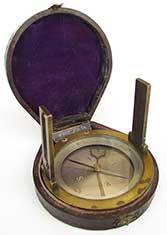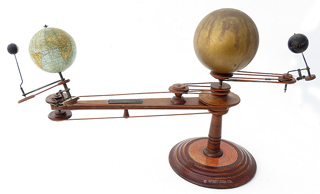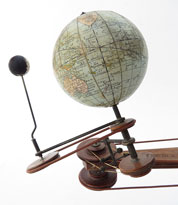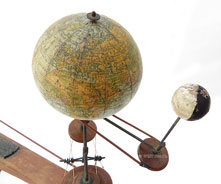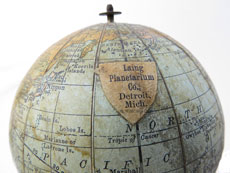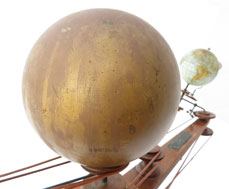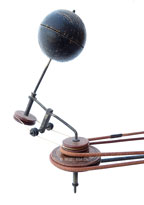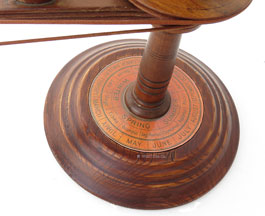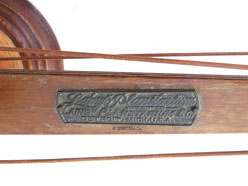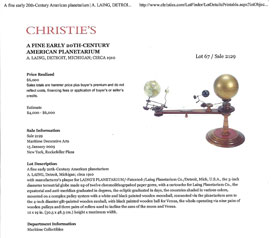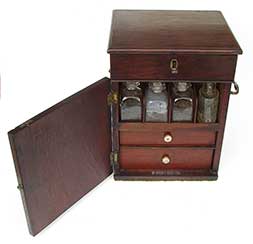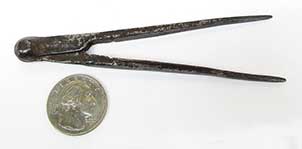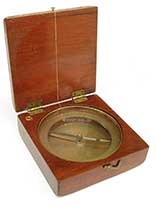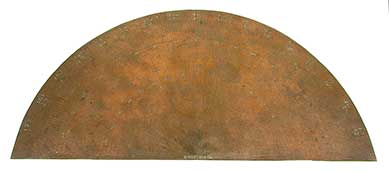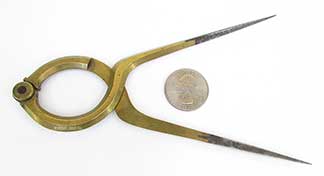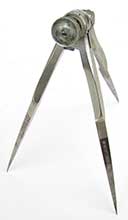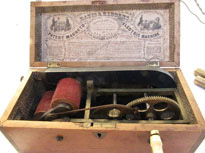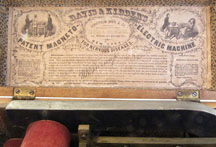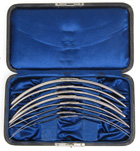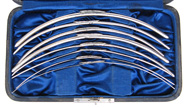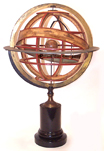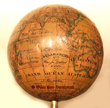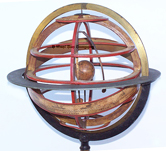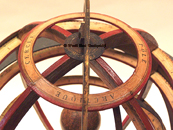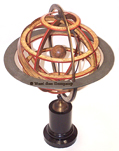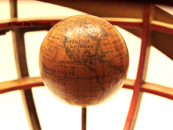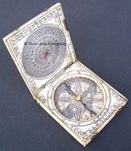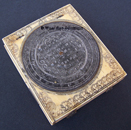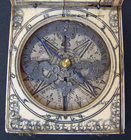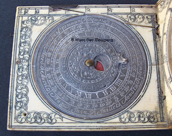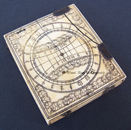SCIENTIFIC & MEDICAL
Catalog Page 9
When no price is shown, use
Click on photos for larger images.
Click
![]() for ordering details.
for ordering details.
|
9.43 POCKET LEVEL. Precision, early 1900’s American optical level made by “D.W. Co.” as stamped on the top. This all brass device features a glazed non-optical tube cleverly combined with a bubble level and prism which enable the viewer to sight an object while concurrently viewing its level in the same frame. The sighting tube in a classic instrument “black crinkle” finish whereas the knurled ends of this instrument and the draw tube are yellow brass. The eye piece pulls outward to focus much like a telescope. 5 1/8ths inches long and just under 6 inches extended. Excellent functional condition exhibiting wear from actual service use. 89 “D. W. Co.” likely stands for “Dietzgen.” The Dietzgen Company, founded in 1885, and noted for its drafting equipment, began its instrument manufactory in 1902. This early level was made in the first part of the 20th century. |
|
PERSPECTIVE
|
EXTENDED
|
MAKER
|
|
9.20 DIP NEEDLE.
Authentic late 19th century American high grade
scientific instrument known as a “dip circle” or
“dipping needle.” This variation of a compass is
made of all brass with a silvered scale reading 90 degrees
at the bottom and calibrated in two degree increments left
and right to “zero” marked by tens. The
fine magnetized needle rests on a pivot supported on a
blackened brass arm extending from the top. The front
of the arm is engraved with the maker’s name “F.
Kroedel” and the reverse is engraved “N. Y.”
The tip of the needle is very close to the scale on the
inside, thus it provides an exact reading. Attesting
to its age, this instrument bears it original old wavy glass
crystal protecting the delicate mechanism. A thin
non-magnetic handle in the form of a circular brass wire is
fitted into the top of the instrument, which pivots
freely. When not in use in folds down around the body
for compact storage. This precise instrument is a
thing of beauty showing very little signs of use and
certainly no abuse. It is housed in its original
hinged mahogany box with brass hook and eye closures.
It measures 3 3/8 inches in diameter and 7 1/8 inches
high suspended. The box measures 4 ½ inches
square and 1 ¼ inches thick. A choice example of
a scarce early scientific instrument.
349 A dip needle is held in the collection of the Coast Guard Museum in Groton, Connecticut. The description reads: “Title: Gurley Dip Needle Lake Superior Model with Case Description: Also known as a Forrester's Compass or Miner's Compass, a dip (or dipping) needle is an instrument for measuring the intensity of the earth's magnetic field. It is also used to locate buried or hidden metal.” |
|
BOX
|
IN BOX
|
NY
|
MAKER
|
|
9.42 CASED ANEMOMETER.
Precision wind anemometer with silvered brass dial
signed “KEUFFEL & ESSER CO. NEW YORK.”
This type of instrument was primarily used to determine
airflow through mineshafts. But it was also used
aboard ship to measure wind velocity on deck. It
consists of a thick circular brass cowling 3 1/8th inches in
diameter. In the center, supported on 3 brass
struts, is the dial with knurled brass bezel and beveled
convex glass crystal measuring 1 1/8 inches
across. There are two dials. The large
outer dial is calibrated in single feet from 0 – 100
on the periphery, marked in 10’s and swept by a fine
blued steel indicator needle. The sub dial registers
hundreds and is marked “HDS.” At the top a
small braking lever is provided to stop the reading.
Behind it is a nickeled brass suspension loop for holding
the instrument in an airway. Attached to the register
is a fan-like propeller with 8 lightweight aluminum vanes
which allow it to register the slightest air current.
This example represents the earliest form of the Davis Biram
anemometer, in that it has no zeroing feature. Complete in
its original handsome machine dove-tailed mahogany case with
brass fittings, 4 inches square and 2 inches thick.
Outstanding original condition in all respects. Circa
1910. This antique instrument is in very clean and
fully functional. 695
The anemometer was invented by Benjamin Biram in 1844. Biram was an employee of Earl Fitzwilliam, Wentworth, Woodhouse, owner of several coal mines in Yorkshire, England. John Davis & Son Ltd. of Derby manufactured the first Biram anemometer in 1845. This instrument was designed to measure the speed of air flowing through a mine shaft. Used in conjunction with a timepiece, it could indicate the volume of air flowing through a mine at a measured interval of time. The formula used was q=av, where q equals the volume of air in cubic feet, a equals the size of the passage in square feet and v equals velocity of the air current in feet per minute as indicated by the anemometer. Anemometers were used by mining personnel daily to check air flow through the mine. |
|
BOX
|
BOX OPEN
|
IN BOX
|
BACK
|
BOTTOM
|
CALIBRATION
|
|
9.38 HYDROMETER. Outstanding
mid-19th century English specific gravity testing set.
This highly precise scientific instrument consists of a gold
plated brass float with a double sided scale marked in
percent from 0-10 divided in 2/10th increments. On the
opposite end is a tear-shaped brass
counterweight. The side of the scale is
stamped “13393 … SIKES…TEMP 51? F.”
The float is complete with all of its brass attachments
which consist of 9 slotted disc weights marked “10 –
90,” each serial numbered “13393.”
These were designed to attach around the counterweight
strut. In addition, there is a single circular weight
which fits on top of the scale. Included in this set
is the original mercury thermometer with ivory scale
calibrated in degrees Fahrenheit from 16 – 98?.
The scale is signed “JOSEPH LONG LTD LONDON” and
retains its original silk cord for suspension. All
components fit neatly in the original velvet-lined mahogany
box with splined construction. The hinged lid has two
brass hooks on post closures. It is decoratively
inlaid with holly stringing and bears an inset ivory plaque
reading “SIKES HYDROMETER –o– J.
LONG 43 EASTCHEAP LONDON.” Additionally,
on the bottom there is a paper label reading (in part) “Adjusted
by JOSEPH LONG, LTD. (Established 1818)” and dated “5
– 9 – 1866.” Totally complete and in
virtually mint condition throughout. This is the
nicest such instrument of the several we have offered in our
35 years in business.
595 |
|
CASE
|
LABEL
|
INTERIOR
|
DETAIL
|
|
9.40 IVORY
CALIPER. Genuine early 1900’s
ivory and brass caliper made even more desirable because it
is an advertising piece. This hand-held precision
instrument has a body of ivory with brass bound fittings and
slide. It is impressed “UNITED BRASSFOUNDERS
& ENGINEERS, Ltd, EMPRESS FOUNDRY – MANCHESTER,
ENG. Makers of Fittings For Steam, Water & Air In Gun
Metal, Brass, Iron, Etc.” It is fitted with a
brass slide which has two scales. One indicates the
thickness of an object up to 4 inches, calibrated to 1/32th
inch and the other indicates the reading in centimeters, up
to 10, calibrated to 1 millimeter. The reverse of this
devices bears two scales engraved on ivory. The first
scale, reading “METRE,” indicates up to 10
centimeters in single millimeter increments. The
other, reading “LONDON” measures the same
distance up to 4 inches in 1/8th inch increments.
Condition of this instrument is excellent. There
is expected minor wear to the markings consistent with
careful use. 4 5/16 inches long closed and about 8
inches long fully extended by 1 inch wide. There is a
small nipple midway in the brass slide to aid its
travel, moving it with a nice tight action. A
great little device about 100 years old. |
|
OPEN
|
DETAIL
|
REVERSE
|
|
9.37 EARLY EQUINOCTIAL SUN
DIAL. Impressive mid-1800’s French “table
dial” of exceptional size and quality. This
precise, solid brass scientific instrument is signed in
lovely hand-engraved script “Cam Opt en Rue De la
Paiac, 24 Paris” at the bottom of the compass
rose. The silvered brass compass rose is finely marked
with the Cardinal, intercardinal and sub points of the
compass as well as being sub-divided to single degrees on
the raised chapter ring. A large hand-engraved arrow
with feathers points from “S” to “N”
terminating in an arrowhead at “0.” The
delicate blued steel compass needle with agate cap rests on
a central pivot surrounded by hand-engraved floral designs
of exquisite quality. The time telling function of
this instrument is accomplished by the interaction of the
needle gnomon, the Latitude arm and the time indications on
the hour plate. The gnomon is spring-loaded and snaps
into place above the center of the compass which would be
oriented to North during a reading. The Latitude arm,
marked from 0 -75 degrees in single increments would be set
to the Latitude of the observer. To these ends the
Latitudes of several prominent cities are engraved around
the dial including “ Pekin, Buenos Ayres, Paris,
Londres, Vera Cruz, and Vienne.” The hour plate
arc is marked in quarter hours with noon “XII”
in the middle, and “IIII” A.M. on the left and “VIII”
P.M. on the right. To insure precise leveling for an
accurate reading this instrument is equipped with two bubble
levels and three knurled screw “feet” for
leveling. The bottom of the instrument is further
hand-engraved with a number of Latitudes for major world
cities including “Havana. Hambourg, Madrid, St.
Petersburg, San Francisco, Berlin, Calcutta, and Algiers,”
among others. Condition of this fine instrument is
superb. It is original condition exhibiting untouched
lacquered finishes with only very minor spotting expected
after 150 years. It comes complete with its equally
handsome leather-bound wooden octagonal case with red-orange
suede interior. The case is hinged and retains its two
brass hook and eye closures. This extraordinary
instrument measures 5 ¾ by 5 ¾ inches and is 1 5/8
inches thick. The case measures 6 ¼ by 6 by 2
inches. Totally complete and fully functional. A
very rare, beautifully preserved example.
2400 |
|
CLOSED
|
IN CASE
|
CASE
|
DETAIL
|
REVERSE
|
|
SIGNATURE
|
BOTTOM
|




